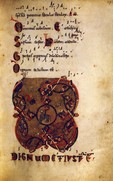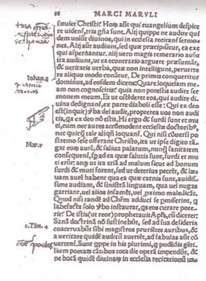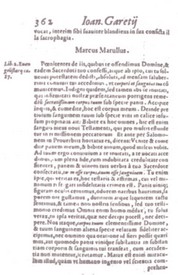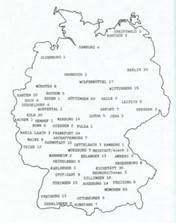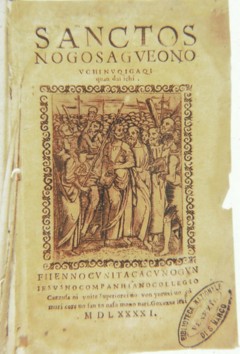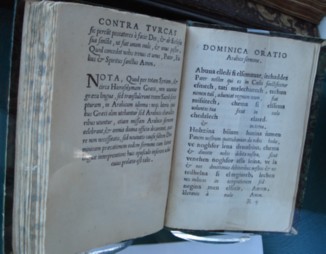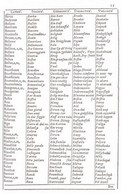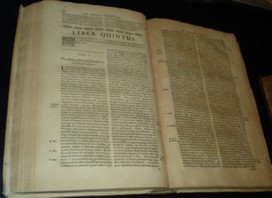SIESC 2007 in CROATIA
European Federation of Christian Teachers
Fédération Européenne d'Enseignants Chrétiens
Europäische Föderation Christlicher Lehrer/innen
You cannot report on half a century in a few pages...
Yves CALAIS, see History
of SIESC
An attempt to briefly describe some achievements of
Croatian Latinists and Humanists
Darko Zubrinic, Zagreb
Pope John Paul II visited Bosnia and Herzegovina twice (1997, 2003 - Ivan Merz beatified), and three times Croatia (1994, 1998 - Cardinal Alojzije Stepinac beatified, 2003 - Marija of the Jesus Crucified Petkovic beatified). His apostolic visit to the city of Zadar in 2003 will always be remembered, like the one by Pope Alexandar III in 1177.
Vekenega Evangelistary (with musical notation), Zadar, 11th century
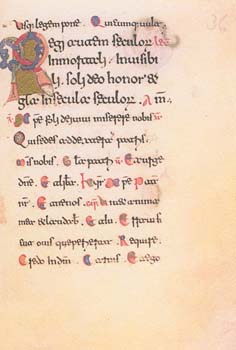 Zadar
was an important European cultural center at that time due to its Benedictine
monastery of St Krsevan (founded in 986, shelled by the Serbs
in 1991), in whose scriptorium the famous Vekenega Evangelistary.
This richly illuminated Latin text from the 11th century is held today
in the Bodleian Library in Oxford (which also possesses other important
Croatian documents written in the Latin, Glagolitic and Croatian Cyrillic Script). Even older is the the Cika
Breviary from the 11th century, written in the Latin script in the
same scriptorium in Zadar. This jewel of Croatian culture represents
the oldest known breviary in Europe, and is kept in the Library of the
Hungarian Academy of Sciences in Budapest. It also contains musical notation.
Another important book written in 1081/82 in Zadar scriptorium of St
Krsevan is Osor Evangelistary (Osor is a town on the island of Cres),
known as Evangeliarium Absarense, held in the Vatican Library (Vat.Bibl.
Ms Bergianum Lat. 339). Zadar is also the oldest university center of
Croatia (1396). For additional information about Croatian art in Zadar see
here.
Zadar
was an important European cultural center at that time due to its Benedictine
monastery of St Krsevan (founded in 986, shelled by the Serbs
in 1991), in whose scriptorium the famous Vekenega Evangelistary.
This richly illuminated Latin text from the 11th century is held today
in the Bodleian Library in Oxford (which also possesses other important
Croatian documents written in the Latin, Glagolitic and Croatian Cyrillic Script). Even older is the the Cika
Breviary from the 11th century, written in the Latin script in the
same scriptorium in Zadar. This jewel of Croatian culture represents
the oldest known breviary in Europe, and is kept in the Library of the
Hungarian Academy of Sciences in Budapest. It also contains musical notation.
Another important book written in 1081/82 in Zadar scriptorium of St
Krsevan is Osor Evangelistary (Osor is a town on the island of Cres),
known as Evangeliarium Absarense, held in the Vatican Library (Vat.Bibl.
Ms Bergianum Lat. 339). Zadar is also the oldest university center of
Croatia (1396). For additional information about Croatian art in Zadar see
here.
Dalmatian rounded beneventana that was in use in the
Zadar scriptorium of St Krsevan shows original characteristics different
from the south-Italian round beneventana.
The church of St. Simun in Zadar possessed an old codex written in Latin script, containing well known lauds from12th century. Zadar had a famous scriptorium at that time. The book disappeared by the end of 19th century, and since 1893 is held in Staatsbibliothek in Berlin, see [Strgacic, p. 374]. Numerous Croatian valuables are held throughout Europe. See a list of Glagolitic books and manuscripts only, held outside of Croatia. Pre-Romanesque architecture in Croatia is described in detail in works of [Delonga].
Augustin Kazotic, a Dominican from the beautiful city of Trogir (13th century), the future bishop of Zagreb, studied at the University of Paris (Sorbonne) by the end of the 13th century. He was reputed to be "an excellent orator and brilliant diplomat" not only in Croatia, but also in France and Italy. He also founded the important Library of Metropolitana in Zagreb, existing continuously from 13th century to these days. Beatified in 1702.
Georges d'Esclavonie (or de Sorbonne, Juraj Slovinac, born in Brezice in present Slovenia, 1355/60-1416), a professor at the University of Paris (Sorbonne) and a theological writer, wrote the first Croatian abecedarium of Christian science in the Glagolitic alphabet about 1400 (held in the Municipal Library in Tours). He wanted to show his renowned colleagues of Sorbonne that except Hebrew, Greek and Latin also existed a genuine Croatian alphabet, or alphabetum chrawaticum as he called it, having a great graphic and lexical value. This Abecdarium of Christian science (containing the Glagolitic alphabet, Our Father, Hail Mary, several Psalms, etc.) is the oldest known Croatian manual for children. Let us reproduce two pages:
Istud alphabetum est Chrawaticum
Catholic
bishops with a unique privilege:
to serve the glagolitic mass
In 1401 he defended his doctorate in theology. In 1403 his name was included in the big scroll of professors of the University of Paris.
Since 1404 he was also a canonist-penitentiary in Tours, in the nun's convent Beaumont, until the end of his life. With his book "Le chasteau de virginite", written in Latin and French in 1411, he entered the history of French and European literature. There exist many of its copies from the 15th century, plus three French printed editions (1505, 1506, 1510) and one Latin (1726), thus proving its popularity in Europe. His manuscripts, some of them written in the Croatian Glagolitic, are held in the City Library (former Cathedral Library) in Tours. He was also very fond of Istria, to which he referred as a part of his Croatian homeland: Istria eadem patria Chrawati. Photos of some of his manuscripts can be seen at Juraj Slovinac (in Croatian). One of his original manuscripts is held at Yale University Library.
Croatian Glagolitic manuscripts held outside of Croatia
A Croatian Dominican priest Beniamin was editor in chief of the first Russian Bible (Gennadij's Bible, finished in 1499) written in Russian Church Slavonic. It was the first Bible also among all Orthodox Christian Slavs. It served as a basis of later printed Russian editions in 1580-81 and 1663, which had spread among Orthodox Christian Slavs. Beniamin's original translations of the Vulgata are even today left unchanged in many parts of the contemporary Russian Bible. It is interesting that the old Russian Bible has many Croatian characteristics in phonetics, morphology and vocabulary, for example,
- kovac (blacksmith)
- loviti (to hunt)
- plijen (prey)
- staja (stable)
- stijena (rock)
- nastojati (to strive)
- puk (common people)
- obitelj (family)
- and even - gusterna (stone water cistern)!
It is clear that he originates from the coastal region of Croatia, probably from the city of Split (according to Vladimir Rozov), and according to Franjo Sanjek, from the Glagolitic environment in the area of Rijeka, Vinodol or Lika
Among Croatian Latinists and writers in Croatian a central place is occupied by Marko Marulic, who is the "father of Croatian literature" (born in Split, 1450-1524). He was the most famous spiritual writer of his time in Europe, and also the first who defined and used the notion of psychology, which is today in current use.
His book De institutione bene vivendi (six volumes, 64 chapters), published in Venice in 1506, had fifteen editions until 1686 and was translated from Latin into
- Italian,
- German (five editions between 1583 and 1614, all in Köln, in parts already in 1568),
- French (7 editions, the first one in 1585),
- Flemish
- Japanese (in Nagasaki, in parts, 1585)
- Portuguese and
- Czech,
altogether 40 editions. It is well known that St. Francis Xaver had taken only two books on his long pilgrimage to the East (India, Japan and China): the Bible and De institutione. Furthermore, in his testament St. Francis Xaver asked that Marulic's book be buried with him. Therefore we may conclude that Marulic was a spiritual father of St. Francis Xaver.
St. Francis Xaver's personal sample of Marulic's book was kept in Madrid in a collection of valuables until 1937, when it had dissapeared. St. Ignazio Loyola included De Insitutione into the list of basic references for the formation of Jesuits. Both St. Francis Xaver and St. Ignazio Loyola were Basques.
Marulic left us many beautiful verses and the epic poem Judita written in the Croatian language, for which he says expressly to be written in the Croatian verses (versi harvatski). Some of his original verses are held in Glasgow (GB). His Judith was translated into English, Hungarian, French, Italian, and some parts into Spanish. Marulic translated from Latin into Croatian the famous "De imitatione Christi" by Thoma de Kempis.
According to investigations of a French specialist Charles Béné, Marulic's texts have been used extensively by Thomas More and Henry VIII. It is known that Marulic's "Evangelistarium" that was read by Henry VIII bears many comments by the King. It is considered that two of the king's three literary works were written under the influence of Marko Marulic. Charles Béné has translated Marulic' Judita from Croatian into French (La Judith).
A page of Marulic's Evangelistarium annotated
personnaly by the English King
Henry VIII, kept in the British Library (843 K 13), see Charles Béné:
La reception des oeuvres de Marulic dans les provinces du Nord ,
in Colloquia Marvliana IIII, Knjizveni krug, Split 1994., p. 51
Marulic's poem "Carmen de Doctrina Domini Nostri Jesu Christi pendentis in cruce" was translated into English as "A Dialogue betwext a Christian and Christ hanging on the Crosse" by St Philip Howard, Earl of Arundel (1557-1595).
According to C. Verdiani, Marulic is also the author of the Florence Codex, which contains a biography of St Jerome written in the Croatian language. There he wrote
and a brilliant crown of the Croatian language.
In Croatian: Jerolim je nass Dalmatin, on je dika, posstenje i slava i svitla kruna hrvatskoga jezika. It is worth mentioning that preserved manuscripts of Marko Marulic show that he also used the cursive glagolitic script.
Marko Marulic sent a dramatic letter to the Pope Hadrian VI, describing an extremely tragic position of the Croats threatened by the onslaughts of the Ottoman Empire and asking for help.
Jean Garret (Ioan Garetij) of Louvain, in his writing De era praesentia corporis Christi in sacrmaneto Eucharistiae, 1561, cites Marko Marulic
His books were known not only in the whole of Europe, but also in Japan (in the 16th century) and South America. For example, parts of De institutione bene vivendi were translated into Japanese already in 1585, published in parts in Nagasaki under the title Sanctos no gosayuno, see Franolic (he mentions 1595 instead of 1585).
More than 500 copies of Marulic's books are kept in Germany (60 libraries), from Franz Leschinkol: Povijesna uloga Evandjelistara i Institucije u 16. stoljecu, in Colloquia Marvliana IIII, Knjizveni krug, Split 1994., pp. 90 and 193
Alonso de Villegas, Spanish author of a famous book Fructus Sanctorum (printed in Paris in 1624), refers to Marulic's De Institutione on almost every page. Another Spanish Christian humanist, Juan Lorenzo Palmierno (Laurentius Palmyrenus), in four of his texts published between 1564 and 1578 mentions expressly to be inspired by Marulic's books. Moreover, in one of his dramas there is a figure called "Marulus". And Professor Michael Neralich (lecturing Spanish and comparative literature at the University of Clermond-Ferrand) considers that the figure of "Andrea Marulo" in the novel Trabajos de Persiles y Sigismunda by Cervantes is inspired by Marulic. There is no doubt that Cervantes was familiar with Marulic's books, since they were translated into Spanish by Fernandez de Ruenga. In the Library of Cristoph Columbo in Sevilla, founded by Hernando Colon (son of Cristoph Columbo), there are many books by Marko Marulic, and even his "Judita" written in Croatian!
Sanctos nogosagveono, 1591, written in Japanese language and in Latin script, contains Marulic's texts; see Franz Leschinkol: Povijesna uloga Evandjelistara i Institucije u 16. stoljecu, in Colloquia Marvliana IIII, Knjizveni krug, Split 1994., pp. 98
When St. Francis Xaver arrived to Kogoshima in Japan in 1549, he also brought Marulic's "De insitutione bene vivendi". According to bishop Hamao from Yokohama, president of Japanese Bishop's Conference and of Asian Caritas, the formation of earliest Japanese Christians had been very probably based on the spirituality of Marulic. See here (in Croatian). It is interesting that in Berlin a monument of Marko Marulic was set up in 2000. In the Library of Congress, Washington, a symposium was held devoted to his work.
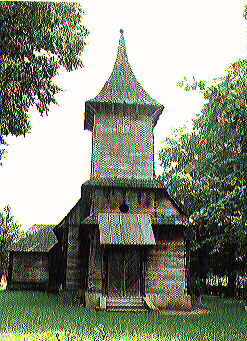 An extremely interesting biography has Bartol
Gyurgieuits (Bartol Jurjevic or Gjurgjevic, born in the region
of Turopolje near Zagreb, known for nice wooden churches, 1506 - 1566?),
a participant of the tragic battle on the Mohac field in 1526, where
he was captured by the Turks and lived as a slave in many parts of
the Turkish Empire. After 13 years of slavery he managed to escape.
Since that time he travelled a lot throughout Europe, agitating for
the creation of a strong union against the Ottoman Empire. His numerous
writings in the Latin language were published first in Antwerpen (1544)
and then extensively reprinted in many other languages: Italian, French,
English, German, Spanish, Dutch, Hungarian, Polish, Czech etc. These
extremely interesting testimonies about the Ottoman (Turkish) Empire
can be found in the libraries of almost all larger European cities:
An extremely interesting biography has Bartol
Gyurgieuits (Bartol Jurjevic or Gjurgjevic, born in the region
of Turopolje near Zagreb, known for nice wooden churches, 1506 - 1566?),
a participant of the tragic battle on the Mohac field in 1526, where
he was captured by the Turks and lived as a slave in many parts of
the Turkish Empire. After 13 years of slavery he managed to escape.
Since that time he travelled a lot throughout Europe, agitating for
the creation of a strong union against the Ottoman Empire. His numerous
writings in the Latin language were published first in Antwerpen (1544)
and then extensively reprinted in many other languages: Italian, French,
English, German, Spanish, Dutch, Hungarian, Polish, Czech etc. These
extremely interesting testimonies about the Ottoman (Turkish) Empire
can be found in the libraries of almost all larger European cities:
Paris, Rome, Vienna, Basel, Leiden, Wittenberg, Florence, London, Prague, Venice, Antwerpen, Liége, Worms, Nürenberg, Krakow, Lyon, Frankfurt etc. (e.g. in 44 towns of Germany alone) and in some cities of the USA.
Bartol Gyurgieuvits: Libellus vere christina lectione dignus diuersas res Turcharum brevi tradens, Rome, 1552, content: De Turcarum ritu et caeremoniis, De afflictionem tam captivorum, Vaticinium infidelium de Christianorum cladibus et calamitatibus, Deploratio cladis christianorum ad potentisimos monarchos; the book contains "Our Father" in the Arabic in written in Latin characters (from the 2006 exhbition in NSK, Zagreb)
Most of his writings contain small dictionaries of the Croatian (which
he calls Slavonian), Turkish, Persian and Hungarian languages. As a part
of his "De afflictione...sub Turcae" (1544) he wrote the first known
Croatian - Latin dictionary (with the basic prayers: Our Father, such
as Hail Mary, Credo), which is also the first known dictionary among
the Croats. He is also the author of the practical Italian - Arabian
- Hebrew - Chaldean dictionary, added to the description of his pilgrimage
to Yerusalem when escaping from the Turkish slavery. It was written in
Italian: "Specchio della peregrinazione delli piu notabili luoghi della
Terra Santa", and the author signed it as Georgievicz de Croatia. He
also mentioned a Croatian Script, which is "different from any other
script in the world" (Glagolitic). He indicates that the Croatian language is
spoken among others on the Constantinople court of Turkish sultans. Gyurgieuivits'
works are also of interest for the study of Islamic
music. He was not only the first Croatian author, but also the first
Slav author whose writings were popular throughout Europe. For more information
see [Zoric].
Branko Franolic: Georgijevic's
Description of Turkish Ways and Customs: Unique Work Published in London
in 1570
The Englishman Hugh Goughe wrote "The Ofspringe of the House of Ottomane" (1570) which is a translation of Gyurgieuits' book "De origine imperii Turcorum". In Goughe's book there is a dialogue in Croatian with a parallel English translation, alongside with two prayers in Croatian (Our father and Hail Mary). Gyugyieuits himself is called the "first Croatian lexicographer" in this book.
Regarding early dictionaries of the Croatian language, let us mention a German knight Arnold von Harf (1471-1505) who visited the Croatian lands along the coast during his pilgrimage to the Holy Land in 1496-1499. His book "Die Pilgerfahrt des Ritters Arnold von Herff von Cöln", published in Köln in 1860, includes a short conversational dictionary of the Croatian language containing 56 words and basic expressions. He also visited the beautiful, strong and freedom loving city of Dubrovnik (as he says), for which he states to be in the Croatian Kingdom - in den Koenynckrijh van Croatijen.
Pavao Skalic, a humanist-polyhistorian (born in Zagreb, 1534-1575), was the first to have used the notion of
in its modern meaning, in his book Encyclopediae seu orbis disciplinarum... (Basel, 1559). He also wrote a musical tractate "Dialogus en Lyra" (Köln, 1570). He used to write his name as Pavao Skalic de Lika, thus indicating the origin of his family.
Faust Vrancic (or Faust Verantius, 1551-1617) from Sibenik was the author of a five language dictionary "Dictionarium quinque nobilissimarum Europeae linguarum: Latinae, Italicae, Germanicae, Dalmaticae et Hungaricae" (Venice, 1595), with more than 5000 words (i.e. altogether 25000 words), where Dalmaticae means Croatian language. Indeed, in his dictionary the words Dalmata, Dalmatia, Dalmaticae are translated as Croat, Croatian land, Croatian respectively. It is known that Vrancic was fluent in at least seven languages. See p. 13 of his Dictionarium:
Faust Vrancic considered that the Dalmatian language was the most beautiful among Slavic languages, and that it was spoken from Adriatic sea to rivers of Drava and Danube. In the second edition to his dictionary, issued in collaboration with a Prague Benedictine Petar Loderecker, the Latin description of Dalmatian language was given as follows: the Croatian language. See [Malic, Na izvorima hrvatskoga jezika, p. 28].
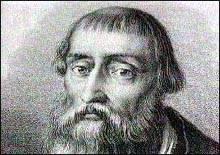
Vrancic's dictionary is dedicated to Alfonso Carillo, a Spanish Jesuit who supported its publication.
His work was an important source for the creation of several subsequent European dictionaries: Hungarian - Italian dictionary written by Bernardino Bali, "Thesaurus polyglottus" by a German humanist and lexicographer Hieronim Megister (1603, "editio secunda " in 1613), and "Dictionarium septem diversarum linguarum (Videlecit Latine, Italice, Dalmatice, Bohemice, Plonice, Germanice et Ungarice)" written by a Czech Benedictine Peterus Lodereckerus Pragensus in 1605.
Faust Vrancic was a chancellor on the Court of king Rudolph II in Prague (Hradcany) from 1581 to 1594, where also a famous musician Adrian de Vries, astronomer Tycho Brache, mathematician and astrologer Johannes Kepler were present. He also wrote about logic and ethics. However, his major contributions are related to numerous technical inventions.
Bartol Kasic (1575-1650), a Croatian Jesuit, was the author of the first Croatian Grammar "Institutiones lingue illyricae", printed in Rome 1604. About the same time he prepared the Croatian - Italian dictionary, which remained unpublished until 1990. In the period of 1631-1636 he translated the whole Bible into spoken Croatian, but unfortunately the book remained only in handwriting. In his "Ritual Rimski" ("Rituale Romanum", Rome, 1640) he cites very old Croatian names for months that are in use even today:
|
- In 1999 we celebrated four centuries of Croatian philology, which has started with Bartol Kasic. His work was very important in standardization of the Croatian language, using the principle "write as you speak".
- He also wrote one of the earliest autobiographic books in Croatia describing the consequences of the Turkish Ottoman occupation. In one of his writings he concludes: I stop here, crying and sighing when I remember all that I saw with my own eyes: profaned churches, settlements completely destroyed, so that nothing was left except tents, hovels, huts. Let God have mercy on us and let him bless us... Let him illuminate us with his Face and Word, and let him have mercy on Croatian people, which is crushed and almost heart-broken.
- In 1612 he opened the gymnasium for the Catholic youth in Belgrade (mostly for children of native Catholics and the Dubrovnik merchants). At that time Belgrade was under the Turks. This was the first gymnasium in Serbia.
- Two samples of Kasic's Cathecism are held in Bibliothéque Nationale (former Bibliothéque Royale) in Paris, France.
Ivan Lucic, or Lucius (born in Trogir, 1604 - Rome, 1679) was the founder of modern Croatian historiography, with his major work "De Regno Dalmatiae et Croatiae libri sex" (Amsterdam, 1666). However, the oldest Croatian historigraphic work is Croatian Chronicle, written by Grgur of Bar in the 12th century.
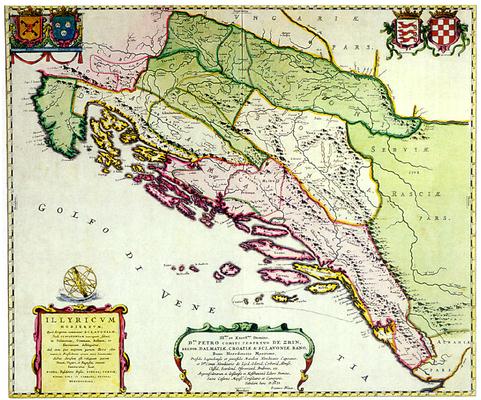
photo from Croatian Historical Musem
Map dedicated to Petar Zrinski, ban of Croatia. The map was created at the workshop of Joannes Blaeu in Amsterdam as an addition to the work by Ivan Lucic, "De Regno Dalmatiae et Croatiae libri sex", Amsterdam, 1666. Blaeu had inserted the map in Atlas Maior in 1667, and dedicated it to the Croatian ban Petar Zrinski (bottom of the map, in the middle):
To the most illustrious and noble lord, Prince Peter of Zrin, the ban of the Kingdom of Dalmatia, Croatia and Slavonia, hereditary ban of the Littoral, hereditary captain of the Legrad fortress and Medimurje peninsula, master and hereditary prince of Lika, Odorje, Krbava, Omis, Klis, Skradin, Ostrovica, Bribir etc.., Master of Kostajnica and the sliver mine at Gvozdansko, councillor and chamberlain to his anointed imperial majesty, master Ioannes Blaeu dedicates this map.
Text from Croatian Historical Musem. Note Croatian coat of arms on the map.
"De Regno Dalmatiae et Croatiae libri sex" (Amstelaedami,
1666),
by Ioannes Lucius
Croatian language was taught in all church Universities in the 17th century as one of six world languages:
- Latin,
- Greek,
- Hebrew,
- Arabian,
- Caldean (Aramaic),
- Illyric (Croatian).
- University of Bologna,
- University of Padova,
- University of Vienna,
- University of Ingolstadt,
- University of Köln,
- University of Louvain,
- University of Paris,
- University of Toulouse,
- University of Salamanca,
- University of Madrid (Alcalà de Henares).
One of the well known Latinists was Rajmund Kunic (1719-1794), who translated the Iliade from Greek into Latin in 1776 (the first edition in Rome, second edition in Venice in 1784). His translation is even today generally regarded as the best one in the world. Kunic was a member of the Accademia dell'Arcadia in Rome.
One of the most outstanding Croatian scientists in history was Rugjer Boskovic (1711-1787), also brilliant Latinist poet. He wrote an extensive scientific poem De solis et lunae defectibus (On Solar and Lunar Eclipse), published in London in 1760. It contains 5570 Latin verses, and was dedicated to the Royal Society of England whose member he was. In the title one can read "Father R. Boskovic, of the Jesuit Order", although at that time it was forbidden for Jesuits to live and work in England. The epic was written in the manner of Roman classics, in dactilus hexameter.
Josip Marinovic (1741 - 1801), was a Jesuit born in Perast - Kotor (in Boka kotorska, annexed to Montenegro in 1945), professor of theology in Venice. His friendship with an Armenian banker Serpos resulted in his interest for the history of Armenians. His assiduous research resulted in the book "Compendio storico...della nazione armena", published in Venice in 1783. The book had a great success. Though it was signed by Serpos, its true author was Marinovic. It represents the first history of Armenians published in Europe. It is interesting that the book had been extended and republished by Ivan Dominik Stratico (1732-1799), bishop on the Croatian island of Hvar. This book incited European interest for Armenian people and their culture. In particular, upon the initiative of the Vatican, supported by Austria and Russia, in 1830 the Turkish sultan admitted very old Armenian Christian Church and allowed Armenian Archbishopric to be founded in Constantinople.
Boka kotorska is also known as the Bay of Croatian saints. Out of eleven Croatian saints and blessed (St Leopold Mandic, St Nikola Tavelic, St Marko of Krizevci, Bl Augustin Kazotic, Bl Ozana of Kotor, Bl Jakov Zadranin, Bl Gracija of Mulo, Bl Julijan of Bale, Bl Alojzije Stepinac, Bl Ivan Merz, Bl Marija Petkovic), three of them are from Boka kotorska:
- St Leopold Bogdan Mandic (1866-1942),
- blessed Ozana Kotorka (Kata Kosic, 1493-1565),
- blessed Gracija from Mulo (1438-1508).
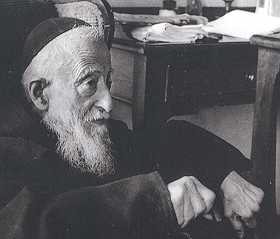
St Leopold Bogdan Mandic (1866-1942, memorial day 30th July) was born in Herceg Novi in Boka kotorska, and died in Padova, Italy. Physically malformed and delicate, having height only 1m 35cm, with clumsy walk and stuttering, he developed tremendous spiritual strength. Although he wanted to be missionary in Eastern Europe, he spent almost all of his adult life in Italy, and lived in Padova from 1906 until the end of his life. He spent also one year in Italian prison during the WWI, since he did not want to renounce his Croatian nationality, see here. He dreamed unceasingly about going to Orient, but one day he gave Communion to a very good person. And, as he described:
After finishing her thanksgiving, she came to me with this message: "Father, Jesus ordered me to say this to you: Your Orient is each of the souls you assist by hearing confessions." (see here).
He became known as Apostle of Confession and Apostle of Unity. Here is a famous prayer in honour of this forerunner of today's Ecumenism:
O God, source of life and love, you gave Saint Leopold a tremendous compassion for sinners and a desire for church unity. Through his prayers, grant that we may acknowledge our need of forgiveness, show love to others, and strive to bring about a living unity among Christians. Through Our Lord Jesus Christ, who lives and reigns for ever and ever. Amen.
Also the famous Pope Sixto V has Croatian roots from Boka kotorska on his father's side.
The name of Mother Teresa (1910-1997, Albanian, born in Skopje in Macedonia), Nobel prize winner for peace 1979, cannot be avoided. The Croatian Jesuits had a great role in her spiritual development. The city of Zagreb, where much later she opened a house (1979), was one of the steps on her road to India. She visited the city of Zagreb and Croatia on several occasions, and always spoke Croatian. Moreover, once she even delivered a sermon in the Zagreb cathedral in Croatian. On that occasion she praised Medjugorje.
The first monument honouring Mother Teresa was carved in Supetar on the island of Brac (2002). It was unveiled by Martin Sheen.
After many years she met her brother who lived in Italy, who forgot his native Albanian (and did not speak English). Surprisingly, they were able to communicate only in Croatian! Her letters written in Croatian to her colleagues in Zagreb are kept in the Zagreb Archbishopric. Also, her prayers (Lord's Prayer, Hail Mary, etc.) pronounced in Croatian were recorded during one of her stays in Croatia. They can be heard from time to time broadcast on Radio Marija.
Pavao Tijan (1908-1997) was a Croatian encyclopaedist born in the city of Senj, close collaborator of Mate Ujevic on the project of Croatian Encyclopaedia (1938-1945). In 1945 he emigrated to Italy, where he published his book Martyrium Croatiae, Rome, 1946. In Spain he was a university professor in Madrid, and known as don Pablo Tijan Roncevic.
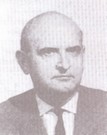
He is a holder of the prestigious medal of the Spanish King - Cruz de Alfonso X el Sabio (Encomienda con Place de Alfonso X El Sabio del Estado espanol por sus meritos en el campo de la cultura). Although being a foreigner, he was
- technical redactor of Encyclopedia de la Cultura Espanola, 1-5, Madrid, 1963-1968,
- close collaborator of editor in chief of the biographic encyclopaedia "Forjadores del Mundo Contemporaneo" (Forgers of the Contemporary World), 1-4, Madrid, 1959-1961,
- collaborator in Las grandes corrientes del pensamiento contemporaneo, Madrid, 1959, I, II,
- collaborator of Geografia Universal, Barcelona 1952.
Premio Brajnovic a la communication is a prestigious Spanish award (500,000 pesets) established in 1996 upon the initiative of newspapermen and lecturers from the University of Pamplon as a recognition to Luka Brajnovic (born in 1919 in Kotor, in Boka kotorska in today's Montenegro), a retired professor of Ethics of the University of Navarra, a former director of the Institute of Artes Liberales, a well known Spanish intellectual. It is interesting that the award was established during his lifetime.

Professor Brajnovic on the right, Prof.
Radovan Grgec, Mrs Brajnovic,
and the King of Dolls on the left, in Pamplon (many
thanks to Prof. Grgec)
He was the dean of the prestigious Faculty of Sciences and Communication of the Universtiy of Pamplon until his retirement, and he educated hundreds of top newspapermen working in Spain and in Latin America. Luka Brajnovic is the author of important monographs, like Deontologia periodista, Literatura de la revolucion bolschevique, Despedidos y encuentras. For more information see the biography of don Brainovic at The University of Navarra, and also here.

![]()
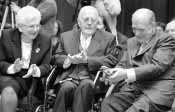
- Premio Brajnovic for 2001 was conferred posthumously to Sinisa Glavasevic, Croatian newspaperman killed in Vukovar in 1991
- Premio Brajnovic for 2005 was conferred to Dr. Joaquin Navarro-Valls, director of The Holly See Press Office, The Vatican. It is interesting that he studied among others at the Faculty of Sciences and Communication in Pamplon where Luka Brainovic was teaching.
 Borislav
Arapovic, born in Bosnia and Hercegovina in 1935,
is honorary director of the Biblical Institute in Stockholm, Sweden.
In 1973 he founded The Institute for Translation of The Bible into
Languages of (former) Soviet Union. In 1996 the Russian Academy of
Sciences conferred him a doctorate honoris causa. In 1999 he was elected
foreign member of the Russian Academy of Sciences. For the creation of
the Children’s Bible in 1983, Dr. Arapovic was awarded the Leo Tolstoy
medal by the Russian Children’s Fund. In the period
of 1983-90 ten editions of the Children’s Bible in five million copies
were printed for free distribution in Russia.
Borislav
Arapovic, born in Bosnia and Hercegovina in 1935,
is honorary director of the Biblical Institute in Stockholm, Sweden.
In 1973 he founded The Institute for Translation of The Bible into
Languages of (former) Soviet Union. In 1996 the Russian Academy of
Sciences conferred him a doctorate honoris causa. In 1999 he was elected
foreign member of the Russian Academy of Sciences. For the creation of
the Children’s Bible in 1983, Dr. Arapovic was awarded the Leo Tolstoy
medal by the Russian Children’s Fund. In the period
of 1983-90 ten editions of the Children’s Bible in five million copies
were printed for free distribution in Russia.
He discovered an amazing pacifist sermon given in 1778 by an anonymous Croatian preacher to Croatian soldiers. The sermon was published in German in 1778, in Dutch in 1778 in the Hague, Amsterdam, and Leeuwarden, in Swedish in 1778 in Norrköping, and in 1779 in Stockholm, and in Latvian in Riga - Leipzig in 1804.
Nearly thousand years of notaryship in Croatia (in Latin and in Croatian, also in Italian), the longest such tradition in Europe.
